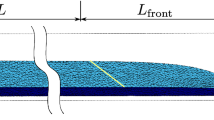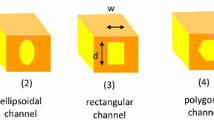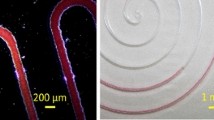Abstract
The spontaneous capillary-driven filling of microchannels is important for a wide range of applications. These channels are often rectangular in cross-section, can be closed or open, and horizontal or vertically orientated. In this work, we develop the theory for capillary imbibition and rise in channels of rectangular cross-section, taking into account rigidified and non-rigidified boundary conditions for the liquid–air interfaces and the effects of surface topography assuming Wenzel or Cassie-Baxter states. We provide simple interpolation formulae for the viscous friction associated with flow through rectangular cross-section channels as a function of aspect ratio. We derive a dimensionless cross-over time, T c, below which the exact numerical solution can be approximated by the Bousanquet solution and above which by the visco-gravitational solution. For capillary rise heights significantly below the equilibrium height, this cross-over time is T c ≈ (3X e/2)2/3 and has an associated dimensionless cross-over rise height X c ≈ (3X e/2)1/3, where X e = 1/G is the dimensionless equilibrium rise height and G is a dimensionless form of the acceleration due to gravity. We also show from wetting considerations that for rectangular channels, fingers of a wetting liquid can be expected to imbibe in advance of the main meniscus along the corners of the channel walls. We test the theory via capillary rise experiments using polydimethylsiloxane oils of viscosity 96.0, 48.0, 19.2 and 4.8 mPa s within a range of closed square tubes and open rectangular cross-section channels with SU-8 walls. We show that the capillary rise heights can be fitted using the exact numerical solution and that these are similar to fits using the analytical visco-gravitational solution. The viscous friction contribution was found to be slightly higher than predicted by theory assuming a non-rigidified liquid–air boundary, but far below that for a rigidified boundary, which was recently reported for imbibition into horizontally mounted open microchannels. In these experiments we also observed fingers of liquid spreading along the internal edges of the channels in advance of the main body of liquid consistent with wetting expectations. We briefly discuss the implications of these observations for the design of microfluidic systems.













Similar content being viewed by others
References
Ahadian S, Mizuseki H, Kawazoe Y (2009) An efficient tool for modeling and predicting fluid flow in nanochannels. J Chem Phys 131:184506. doi:10.1063/1.3253701
Ayyaswamy PS, Catton I, Edwards DK (1974) Capillary flow in triangular grooves. J Appl Mech 41:332–336. doi:10.1115/1.3423288
Baret J-C, Decré MMJ, Herminghaus S, Seemann R (2007) Transport dynamics in open microfluidic grooves. Langmuir 23:5200–5204. doi:10.1021/la063584c
Bertrand E, Blake TD, de Coninck J (2009) Influence of solid-liquid interactions on dynamic wetting: a molecular dynamics study. J Phys: Condens Matter 21:464124. doi:10.1088/0953-8984/21/46/464124
Bico J (2000) Mécanismes d’ imprégnation: surfaces texturées, Bigouttes, Poreux. PhD thesis, Université de Paris VI
Bico J, Quéré D (2002) Rise of liquids and bubbles in angular capillary tubes. J Colloid Interface Sci 247:162–166. doi:10.1006/jcis.2001.8106
Bico J, Quéré D (2003) Precursors of impregnation. Europhys Lett 61:348–353. doi:10.1209/epl/i2003-00196-9
Bico J, Thiele U, Quéré D (2002) Wetting of textured surfaces. Colloids Surf A 206:41–46. doi:10.1016/S0927-7757(02)00061-4
Blake TD, Coninck J (2004) The influence of pore wettability on the dynamics of imbibition and drainage. Colloids Surf A 250:395–402. doi:10.1016/j.colsurfa.2004.05.024
Blake TD, Haynes JM (1969) Kinetics of liquid/liquid discplacement. J Colloid Interface Sci 30:421–423. doi:10.1016/0021-9797(69)90411-1
Bouaidat S, Hansen O, Bruus H et al (2005) Surface-directed capillary system; Theory, experiments and applications. Lab Chip 5:827–836. doi:10.1039/b502207j
Bousanquet C (1923) On the flow of liquids into capillary tubes. Philos Mag Ser 6(45):525–531. doi:10.1080/14786442308634144
Brody JP, Yager P, Goldstein RE, Austin RH (1996) Biotechnology at low Reynolds numbers. Biophys J 71:3430–3441. doi:10.1016/S0006-3495(96)79538-3
Byon C, Kim SJ (2011) The effect of meniscus on the permeability of micro-post arrays. J Micromech Microeng 21:115011. doi:10.1088/0960-1317/21/11/115011
Chebbi R (2007) Dynamics of liquid penetration into capillary tubes. J Colloid Interface Sci 315:255–260. doi:10.1016/j.jcis.2007.06.073
Chen Y, Melvin LS, Rodriguez S et al (2009) Capillary driven flow in micro scale surface structures. Microelectron Eng 86:1317–1320. doi:10.1016/j.mee.2009.02.016
Clime L, Brassard D, Pezacki JP, Veres T (2012) Self-priming of liquids in capillary autonomous microfluidic systems. Microfluid Nanofluid 12:371–382. doi:10.1007/s10404-011-0881-7
Concus P, Finn R (1969) On the behavior of a capillary surface in a wedge. Proc Natl Acad Sci USA 63:292–299. doi:10.1073/pnas.63.2.292
Cox RG (1986) The dynamics of the spreading of liquid on a solid-surface. 1. Viscous-flow. J Fluid Mech 168:169–194. doi:10.1017/S0022112086000332
Darhuber A, Troian S, Reisner W (2001) Dynamics of capillary spreading along hydrophilic microstripes. Phys Rev E 64:1–8. doi:10.1103/PhysRevE.64.031603
de Gennes PG (1985) Wetting—statics and dynamics. Rev Mod Phys 57:827–863. doi:10.1103/RevModPhys.57.827
Dong M, Chatzis I (1995) The imbibition and flow of a wetting liquid along the corners of a square capillary tube. J Colloid Interface Sci 172:278–288. doi:10.1006/jcis.1995.1253
Fries N, Dreyer M (2008a) The transition from inertial to viscous flow in capillary rise. J Colloid Interface Sci 327:125–128. doi:10.1016/j.jcis.2008.08.018
Fries N, Dreyer M (2008b) An analytic solution of capillary rise restrained by gravity. J Colloid Interface Sci 320:259–263. doi:10.1016/j.jcis.2008.01.009
Fries N, Dreyer M (2009) Dimensionless scaling methods for capillary rise. J Colloid Interface Sci 338:514–518. doi:10.1016/j.jcis.2009.06.036
Girardo S, Cingolani R, Chibbaro S, Diotallevi F, Succi S, Pisignano D (2009) Corner liquid imbibitions during capillary penetration in lithographically made microchannels. Appl Phys Lett 94:171901–171903. doi:10.1063/1.3123804
Girardo S, Palpacelli S, De Maio A, Cingolani R, Succi S, Pisignano D (2012) Interplay between shape and roughness in early stage microcapillary imbibition. Langmuir 28:2596–2603. doi:10.1021/la2045724
Hamraoui A, Nylander T (2002) Analytical approach for the Lucas–Washburn equation. J Colloid Interface Sci 250:415–421. doi:10.1006/jcis.2002.8288
Hamraoui A, Thuresson K, Yaminsky V, Nylander T (2000) Can a dynamic contact angle be understood in terms of a friction coefficient? J Colloid Interface Sci 226:199–204. doi:10.1006/jcis.2000.6830
Han A, Mondin G, Hegelbach NG et al (2006) Filling kinetics of liquids in nanochannels as narrow as 27 nm by capillary force. J Colloid Interface Sci 293:151–157. doi:10.1016/j.jcis.2005.06.037
Hoffman RL (1975) Study of advancing interface. 1. Interface shape in liquid-gas systems. J Colloid Interface Sci 50:228–241. doi:10.1016/0021-9797(75)90225-8
Ichikawa N, Hosokawa K, Maeda R (2004) Interface motion of capillary-driven flow in rectangular microchannel. J Colloid Interface Sci 280:155–164. doi:10.1016/j.jcis.2004.07.017
Ishino C, Reyssat M, Reyssat E et al (2007) Wicking within forests of micropillars. Europhys Lett. doi:10.1209/0295-5075/79/56005
Jokinen V, Franssila S (2008) Capillarity in microfluidic channels with hydrophilic and hydrophobic walls. Microfluid Nanofluid 5:443–448. doi:10.1007/s10404-008-0263-y
Jong W, Kuo T, Ho S et al (2007) Flows in rectangular microchannels driven by capillary force and gravity. Int Commun Heat Mass Transfer 34:186–196. doi:10.1016/j.icheatmasstransfer.2006.09.011
Krotov VV, Rusanov AI (1999) Physicochemical hydrodynamics of capillary systems. Imperial College Press, p 222
Kusumaatmaja H, Pooley CM, Girardo S et al (2008) Capillary filling in patterned channels. Phys Rev E 77:3–6. doi:10.1103/PhysRevE.77.067301
Legait B (1983) Laminar flow of two phases through a capillary tube with variable square cross-section. J Colloid Interface Sci 96:28–38. doi:10.1016/0021-9797(83)90005-X
Liou WW, Peng Y, Parker PE (2009) Analytical modeling of capillary flow in tubes of nonuniform cross section. J Colloid Interface Sci 333:389–399. doi:10.1016/j.jcis.2009.01.038
Liu W, Li Y, Cai Y, Sekulic DP (2011) Capillary rise of liquids over a microstructured solid surface. Langmuir 27:14260–14266. doi:10.1021/la2033884
Lucas R (1918) Ueber das Zeitgesetz des Kapillaren Aufstiegs von Flussigkeiten. Kolloid Z 23:15–22. doi:10.1007/BF01461107
Marmur A, Cohen RD (1997) Characterization of porous media by the kinetics of liquid penetration: the vertical capillaries model. J Colloid Interface Sci 189:299–304. doi:10.1006/jcis.1997.4816
McHale G, Shirtcliffe NJ, Aqil S et al (2004) Topography driven spreading. Phys Rev Lett 93:1–4. doi:10.1103/PhysRevLett.93.036102
Mehrabian H, Gao P, Feng JJ (2011) Wicking flow through microchannels. Phys Fluids 23:122108. doi:10.1063/1.3671739
Mognetti BM, Yeomans JM (2009) Capillary filling in microchannels patterned by posts. Phys Rev E 80:1–8. doi:10.1103/PhysRevE.80.056309
Mumley TE, Radke C, Williams MC (1986) Kinetics of liquid/liquid capillary rise: I. Experimental observations. J Colloid Interface Sci 109:398–412. doi:10.1016/0021-9797(86)90318-8
Oh JM, Faez T, Beer S, Mugele F (2009) Capillarity-driven dynamics of water–alcohol mixtures in nanofluidic channels. Microfluid Nanofluid 9:123–129. doi:10.1007/s10404-009-0517-3
Ponomarenko A, Quéré D, Clanet C (2011) A universal law for capillary rise in corners. J Fluid Mech 666:146–154. doi:10.1017/S0022112010005276
Popescu MN, Ralston J, Sedev R (2008) Capillary rise with velocity-dependent dynamic contact angle. Langmuir 24:12710–12716. doi:10.1021/la801753t
Quéré D (1997) Inertial capillarity. Europhys Lett 39:533–538. doi:10.1209/epl/i1997-00389-2
Quéré D (2008) Wetting and roughness. Annu Rev Mater Res 38:71–99. doi:10.1146/annurev.matsci.38.060407.132434
Ramé E, Weislogel MM (2009) Gravity effects on capillary flows in sharp corners. Phys Fluids 21:042106. doi:10.1063/1.3109685
Ransohoff T, Radke CJ (1988) Laminar flow of a wetting liquid along the corners of a predominantly gas-occupied noncircular pore. J Colloid Interface Sci 121:392–401. doi:10.1016/0021-9797(88)90442-0
Reyssat M, Courbin L, Reyssat E, Stone HA (2008) Imbibition in geometries with axial variations. J Fluid Mech 615:335–344. doi:10.1017/S0022112008003996
Romero LA, Yost FG (2006) Flow in an open channel capillary. J Fluid Mech 322:109–129. doi:10.1017/S0022112096002728
Rosendahl U, Ohlhoff A, Dreyer ME (2004) Choked flows in open capillary channels: theory, experiment and computations. J Fluid Mech 518:187–214. doi:10.1017/S0022112004001041
Schoelkopf J, Gane PAC, Ridgway CJ, Matthews GP (2002) Practical observation of deviation from Lucas–Washburn scaling in porous media. Colloids Surf 206:445–454. doi:10.1016/S0927-7757(02)00066-3
Seemann R, Brinkmann M, Kramer EJ, Lange FF, Lipowsky R (2005) Wetting morphologies at microstructured surfaces. Proc Natl Acad Sci USA 102:1848–1852. doi:10.1073/pnas.0407721102
Shirtcliffe NJ, McHale G, Newton MI et al (2006) Critical conditions for the wetting of soils. Appl Phys Lett 89:094101. doi:10.1063/1.2339072
Shirtcliffe NJ, McHale G, Atherton S, Newton MI (2010) An introduction to superhydrophobicity. Adv Colloid Interface Sci 161:124–138. doi:10.1016/j.cis.2009.11.001
Siebold A, Nardin M, Schultz J et al (2000) Effect of dynamic contact angle on capillary rise phenomena. Colloids Surf A 161:81–87. doi:10.1016/S0927-7757(99)00327-1
Squires T, Quake SR (2005) Microfluidics: fluid physics at the nanoliter scale. Rev Mod Phys 77:977–1026. doi:10.1103/RevModPhys.77.977
Srivastava N, Din C, Judson A et al (2010) A unified scaling model for flow through a lattice of microfabricated posts. Lab Chip 10:1148–1152. doi:10.1039/b919942j
Stange M, Dreyer ME, Rath HJ (2003) Capillary driven flow in circular cylindrical tubes. Phys Fluids 15:2587–2601. doi:10.1063/1.1596913
Staples TL, Shaffer DG (2002) Wicking flow in irregular capillaries. Colloids Surf A 204:239–250. doi:10.1016/S0927-7757(01)01138-4
Stukan MR, Ligneul P, Crawshaw JP, Boek ES (2010) Spontaneous imbibition in nanopores of different roughness and wettability. Langmuir 26:13342–13352. doi:10.1021/la101995t
Tartakovsky A, Meakin P (2005) Modeling of surface tension and contact angles with smoothed particle hydrodynamics. Phys Rev E 72:02630. doi:10.1103/PhysRevE.72.026301
Washburn EW (1921) The dynamics of capillary flow. Phys Rev 17:273–283. doi:10.1103/PhysRev.17.273
Weislogel MM, Baker JA, Jenson RM (2011) Quasi-steady capillarity-driven flows in slender containers with interior edges. J Fluid Mech 685:271–305. doi:10.1017/jfm.2011.314
Xiao Y, Yang F, Pitchumani R (2006) A generalised analysis of capillary flow in channels. J Colloid Interface Sci 298:880–888. doi:10.1016/j.jcis.2006.01.005
Xue HT, Fang ZN, Yang Y, Huang JP, Zhou LW (2006) Contact angle determined by spontaneous dynamic capillary. Chem Phys Lett 432:326–330. doi:10.1016/j.cplett.2006.10.017
Yang D, Krasowska M, Priest C, Popescu MN, Ralston J (2011) Dynamics of capillary-driven flow in open microchannels. J Phys Chem C 115:18761–18769. doi:10.1021/jp2065826
Yost F, Holm E (1995) Capillary flow on narrow strips and in V-shaped grooves. Advances in electronic packaging. In: Proceedings of INTERPACK’95 conference, ASME EEP, vol 10, pp 1265–1271
Zhu Y, Petkovic-Duran K (2010) Capillary flow in microchannels. Microfluid Nanofluid 8:275–282. doi:10.1007/s10404-009-0516-4
Acknowledgments
The authors acknowledge financial assistance from the UK Engineering and Physical Sciences Research Council (Grant No. EP/E063489/1). HJ would like to acknowledge Nottingham Trent University for financial support.
Author information
Authors and Affiliations
Corresponding author
Rights and permissions
About this article
Cite this article
Ouali, F.F., McHale, G., Javed, H. et al. Wetting considerations in capillary rise and imbibition in closed square tubes and open rectangular cross-section channels. Microfluid Nanofluid 15, 309–326 (2013). https://doi.org/10.1007/s10404-013-1145-5
Received:
Accepted:
Published:
Issue Date:
DOI: https://doi.org/10.1007/s10404-013-1145-5




